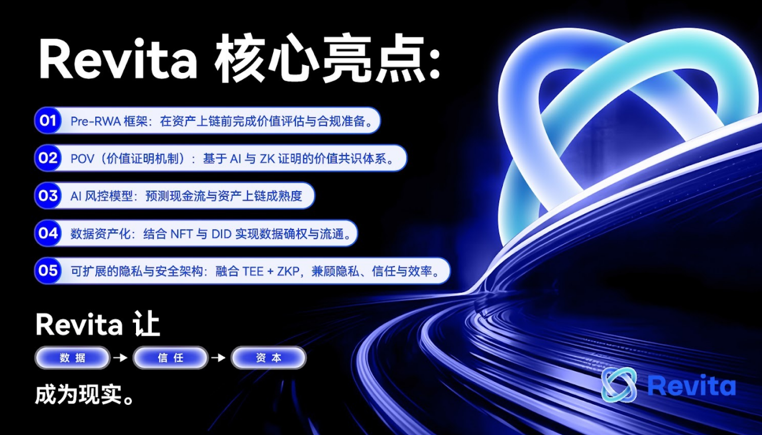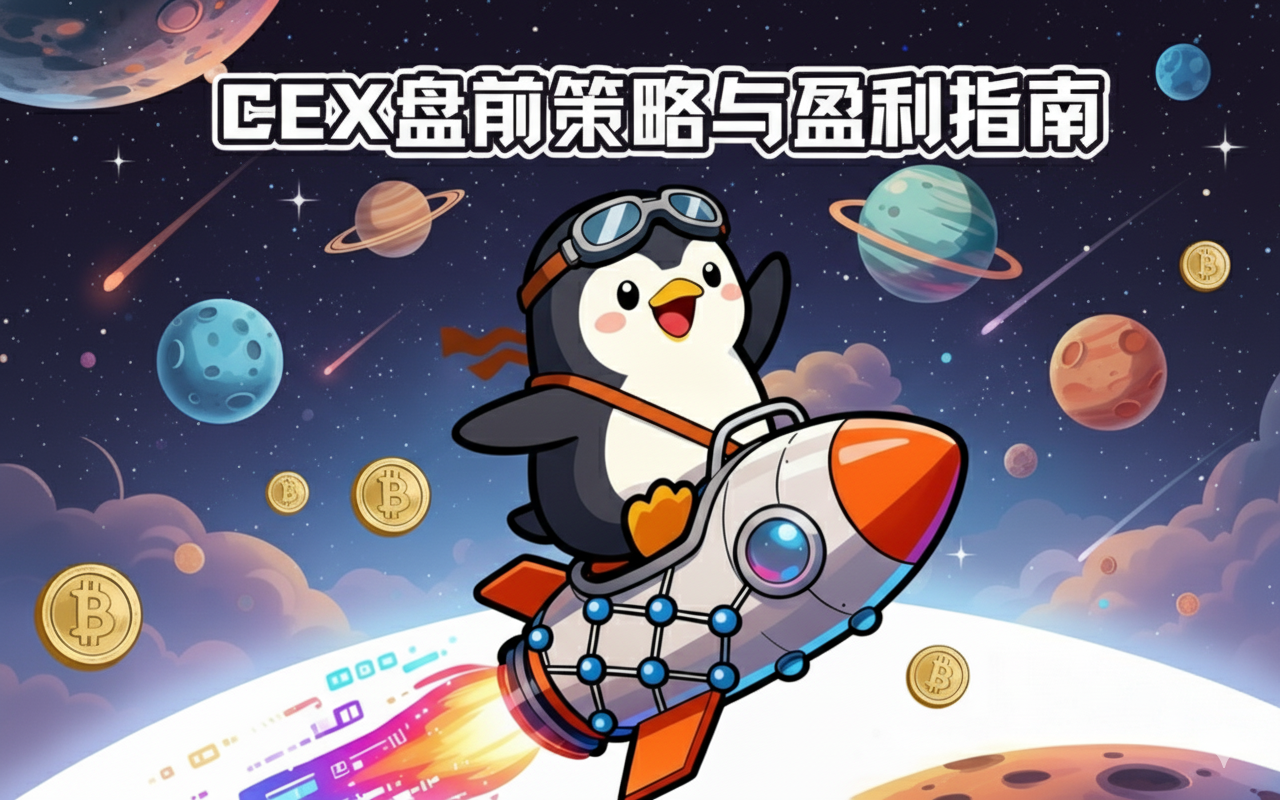Revita Network: Reshaping the future of RWA, unlocking the true value of smart devices.
In the data-driven era, the global economy is entering a critical stage of evolution from the information internet to the value internet.
Real-world assets (RWAs) are considered one of the most promising areas for blockchain applications. However, most RWA projects currently focus only on the "on-chain" result, neglecting the credible assessment and compliance verification before assets are added to the blockchain.
The emergence of Revita Network offers a new answer to this question. As a decentralized infrastructure network that integrates AI, Web3, and the Internet of Things (IoT), Revita is committed to reshaping the tokenization process of real-world assets and has proposed a forward-looking concept—Pre-RWA (Pre-RWA).
Its goal is to enable assets to complete value assessment, credibility verification, and compliance processing before they are put on the blockchain, thereby fundamentally improving the credibility and liquidity of real-world assets in the blockchain world.
I. Reconstructing the Trust Foundation of RWA
Traditional RWA projects often rely on centralized audits and third-party asset valuations, which can lead to problems such as high costs, strong subjectivity, and insufficient transparency.
Revita uses the "Pre-RWA" model as its core innovation path, starting from the process before assets are put on the blockchain, to establish a credible value foundation for assets.
This model uses AI models and multi-source IoT data to verify the authenticity and calculate the value of assets. Combined with regulatory compliance and privacy protection mechanisms, it enables assets to have traceability, verifiability, and financing capabilities before they are put on the blockchain.
This "data-to-value" model makes Revita a crucial connecting layer between real-world assets and Web3 capital.
II. Two-tier architecture design: Balancing decentralization and compliance
Revita Network's system architecture consists of two layers:
1. Global Protocol Layer
Deployed on high-performance Layer 2 blockchains (such as Arbitrum), it is responsible for global governance, asset verification, incentive distribution, and network security, ensuring the transparency and decentralization of the system.
2. Local Compliance Layer
Operated by licensed institutions, it provides compliant asset management and value verification services tailored to the legal frameworks and data sovereignty requirements of different countries and regions.
At this layer, Revita uses artificial intelligence models to assess the value of devices and data, and uses Trusted Execution Environment (TEE) and Zero-Knowledge Proof (ZKP) technologies to ensure data privacy and security.
This "two-tier design" enables Revita to meet the needs of global expansion while maintaining compliant operations under different regulatory systems, providing a new standardized path for decentralized physical infrastructure networks (DePIN).
III. Core Technological Advantages
1. Pre-RWA Framework
Completing trust assessments and compliance verifications before assets are put on the blockchain provides a more solid foundation of trust for the RWA market.
2. POV (Proof of Value) Mechanism
An AI-based value proof model, combined with zero-knowledge proof technology, quantifies and verifies the contributions of smart devices, thereby achieving transparent and fair incentive distribution.
3. AI-powered risk control and prediction system
It supports cash flow forecasting, asset risk analysis, and financing potential assessment, providing quantitative basis for financing smart devices and real assets.
4. Data Assetization Ecosystem
By leveraging NFTs and decentralized identity (DID) to establish device data ownership, put it on the blockchain, and incentivize it, data can circulate within a trusted framework and create economic value.
5. Scalable privacy and security architecture
By combining Trusted Execution Environment (TEE) and Zero-Knowledge Proof (ZKP) technologies, it achieves efficient collaboration between off-chain computation and on-chain verification, balancing efficiency, privacy, and compliance.

IV. Market Opportunities: The Convergence Wave of AI × IoT × RWA
The global economy is currently in a phase of integration between intelligent technology and asset digitization.
Industry forecasts predict that by 2030, the number of connected devices worldwide will exceed 750 billion, and the AIoT (Artificial Intelligence of Things) market size is expected to surpass $2 trillion. Meanwhile, the maturity of Web3 technology is providing a credible technological and financial foundation for the tokenization of real-world assets.
According to research data from Messari, the potential size of the RWA market is estimated to be as high as $3.5 trillion.
At this crossroads, Revita is entering a blue ocean market through the “Pre-RWA” model, transforming long-undervalued and illiquid assets in the physical world into verifiable, tradable, and financeable on-chain assets.
V. Development Path: From Smart Devices to a Global Asset Network
Revita's development blueprint will proceed step by step, starting with the value capture of smart devices, and gradually building a global network of trusted assets.
In its early stages, Revita will focus on building a smart device contribution and data ownership system to lay a foundation of trust for the flow of data in the real world.
Subsequently, the project will further refine the "Pre-RWA" framework, combining AI with compliance mechanisms to provide credible value assessment and financing support for the Internet of Things and real-world infrastructure.
In its mature phase, Revita plans to promote global RWA asset mobility and financial interoperability, creating an open network connecting the real world with the decentralized finance system.
This phased approach reflects Revita's systematic evolution from "data trustworthiness" to "asset valuation" and then to "capital circulation," aiming to build a long-term sustainable global digital asset ecosystem.
VI. Core Ecosystem Assets (RVT)
The RVT token has the following functions:
Governance rights: Holders can vote to determine key parameters of the agreement;
Node staking: Validators must stake RVT as network collateral;
Fee burning + dividends: Part of the fees are burned to achieve deflation, and part is distributed to the pledgers;
RWA Collateral: Can be used as collateral for the tokenization of real-world assets.
The total supply of RVT is capped at 10 billion, and a similar "halving mechanism" issuance model is adopted to ensure incentive sustainability.
VII. Impact on Industry
For device manufacturers and DePIN developers:
Revita provides a quantifiable equipment value assessment system, enabling the contribution of equipment to be measured and incentivized, thereby forming new business models.
For investors and asset management institutions:
Revita offers a reliable valuation system based on data and AI models, reducing risk and increasing the transparency of investment decisions.
For Web3 developers and infrastructure builders:
Revita provides standardized APIs and SDKs to help developers bring real-world data into the blockchain, enabling more innovative DApps and AI applications.
VIII. Summary
Revita is building critical infrastructure that connects the physical world with digital capital.
By integrating AI, Web3, and IoT, Revita not only promotes the trustworthy on-chaining of real-world assets, but also provides underlying support for value verification and compliance trust for the future decentralized economic system.
As global attention to RWA continues to grow, the "Pre-RWA" model represented by Revita will become a new standard for the integration of blockchain with the real economy.
This is not just a technological innovation, but a systemic reconstruction of trust, asset liquidity, and real value.
- 核心观点:Revita Network通过Pre-RWA重构资产代币化信任基础。
- 关键要素:
- AI与IoT验证资产真实性。
- 双层架构兼顾去中心化与合规。
- POV机制实现透明激励分配。
- 市场影响:提升RWA市场可信度与流动性。
- 时效性标注:长期影响



